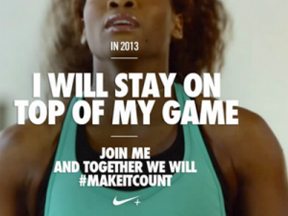Do you want to use Pinterest as a marketing channel for your ecommerce business? This article will give you the essential dos and don’ts for the best chance of success.
Pinterest Dos for Ecommerce Merchants
Optimize your images for Pinterest. Pinterest is driven primarily by imagery, so it’s crucial to optimize your images specifically for the platform. Below you’ll find some best practice image dimensions that will help make a great first impression, and offer your viewer the best mobile experience.
But optimizing your pins isn’t just about dimension sizes. To get the best return, use only high quality and preferably original graphics.
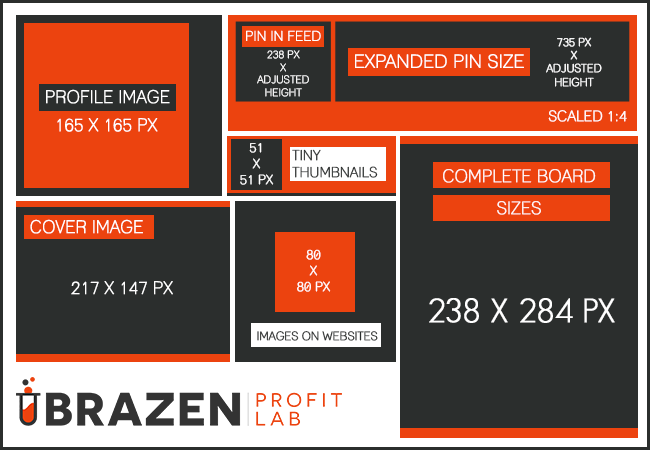
Pinterest size dimension cheat sheet.
Use images and text. Yes, Pinterest is heavily geared towards photography, but text-based graphics, and images that incorporate text can be just as effective. Adding additional text to your pins can do three important things.
- Make your images branded and more recognizable.
- Give important product or availability information.
- Include your website URL, so the image source can’t change when it’s repinned.
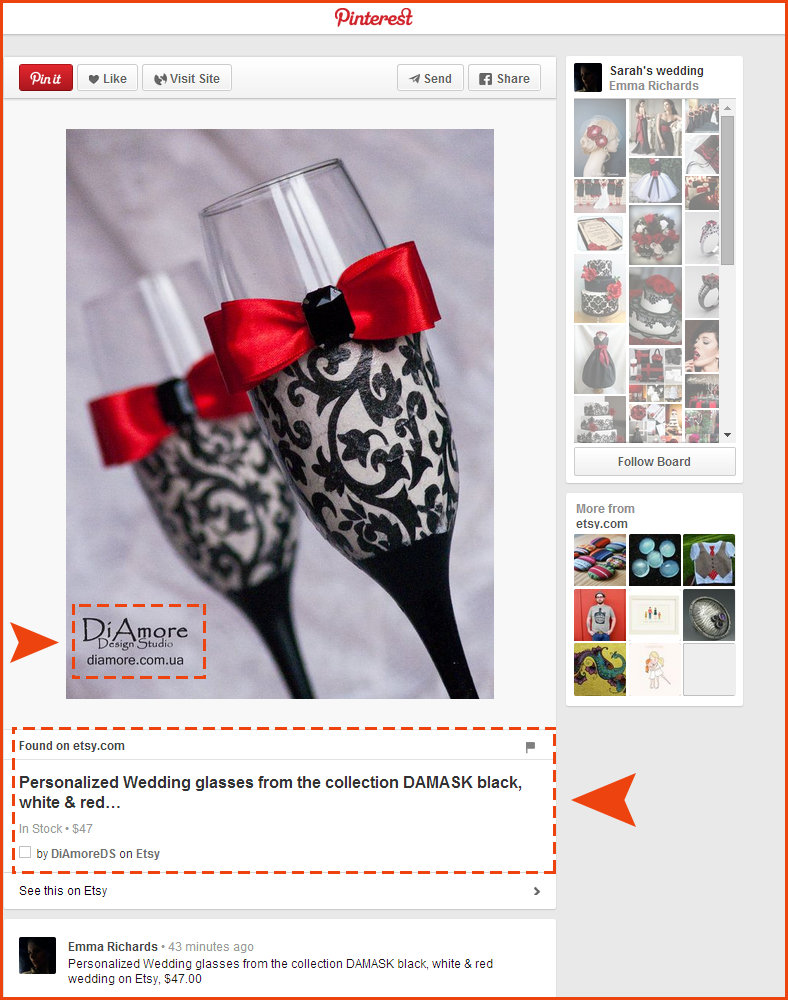
Branded graphic on Pinterest
Make sure you’re linking back to the specific page, not the home page. Many ecommerce business owners make the error of redirecting interested prospects to their home page, rather than the specific landing page where their product can be found. Your link destination should take your viewer to exactly where the product can be viewed and bought. If you save them the trouble of searching for it, you’ll increase your chances of a sale or inquiry.
Include a “Pin it” button on all your images. Failing to include a pin button for the product images on your website can be a costly oversight. There are no shortages of free plugins to help make your website more Pinterest friendly.
“Pin it” plugin button. This plugin (my favorite) makes your images transparent and shows a prominent “Pin it” button every time a viewer scrolls over an image on your site. The first image, below, has no Pin it button; the second image does.

Graphic without pin button.

Graphic with pin button.
Interact with new followers. Pinterest records followers of all your board’s only as profile followers. But some prospects will just follow certain boards. Why? These boards speak to their specific interests. Don’t ignore these followers. In the Pinterest dashboard it’s easy to see when new visitors have followed individual boards, repinned your pins, or liked your pins.
Try to find a way to interact with these prospects. Follow one of their boards back. Repin one of their pins, or simply thank them for the like. Make them feel acknowledged, and in turn they’ll be more likely to follow more of your boards.
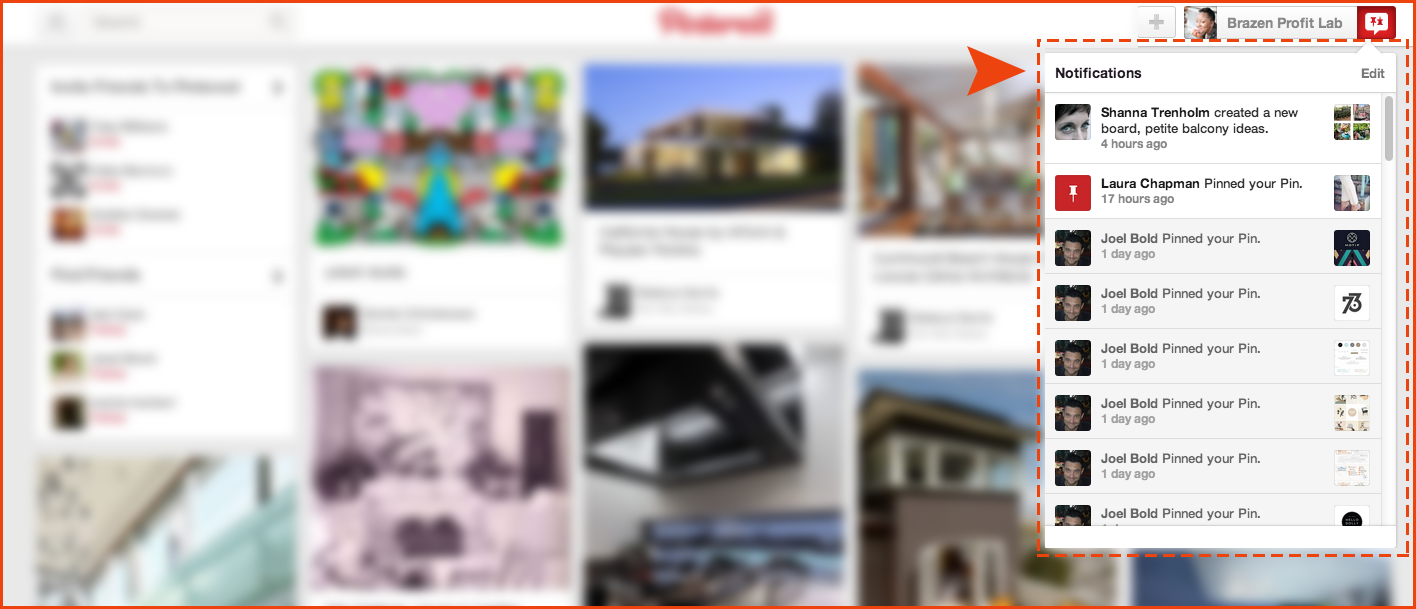
Pinterest notifications.
Find ways to connect relevant images you pin or repin back to your brand. Whether repinning content found within the platform, or pinning from another website, when you share images not from your brand to the platform (as you should), try to find a way to make it relevant to your brand or product.
This simple strategy of pairing other brands products with your own in a complementary way does two things.
- It helps you connect with other ecommerce store owners, paving the way for potential partnerships and joint ventures.
- It provides inspiration to your viewer. Inspiration and desire ultimately lead to more sales.
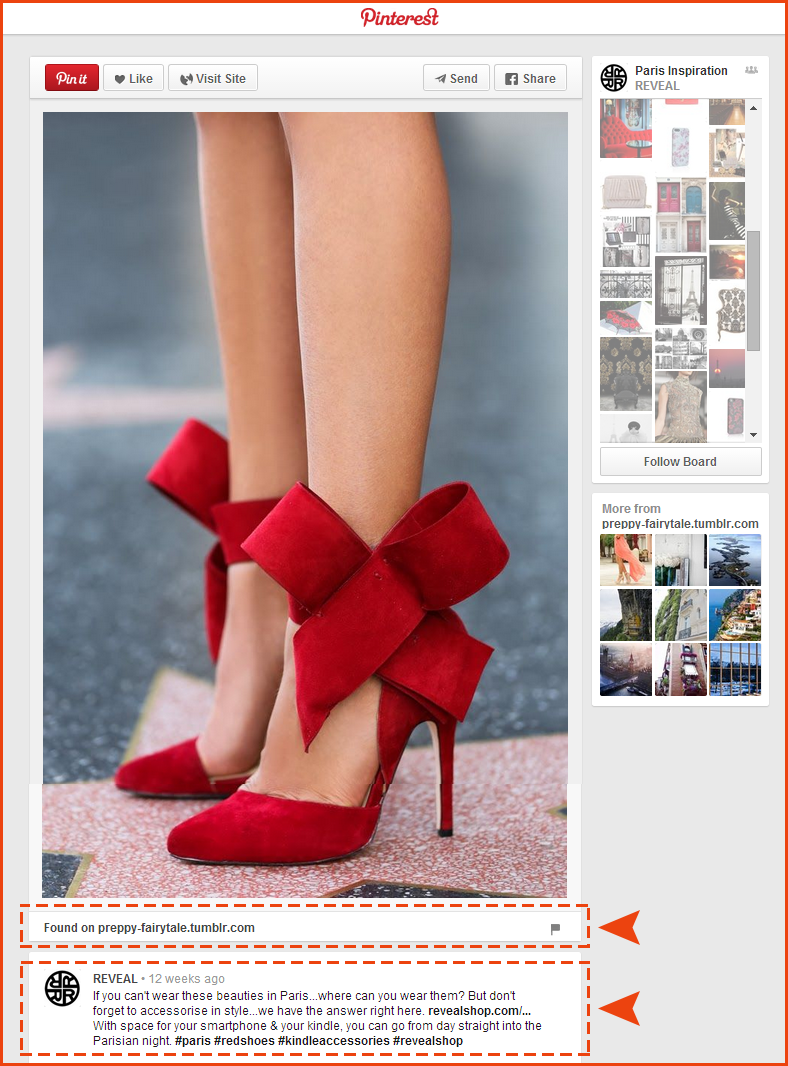
Red shoe back link.
Optimize board descriptions and cover images. Don’t ignore the description area. Use your copywriting skills to give readers a reason to follow your boards. Pinterest also lets you select which pin to use as your cover image, so don’t forget to optimize the cover image of each board by selecting the most eye catching, bright and, if possible, branded image to use as your cover photo.
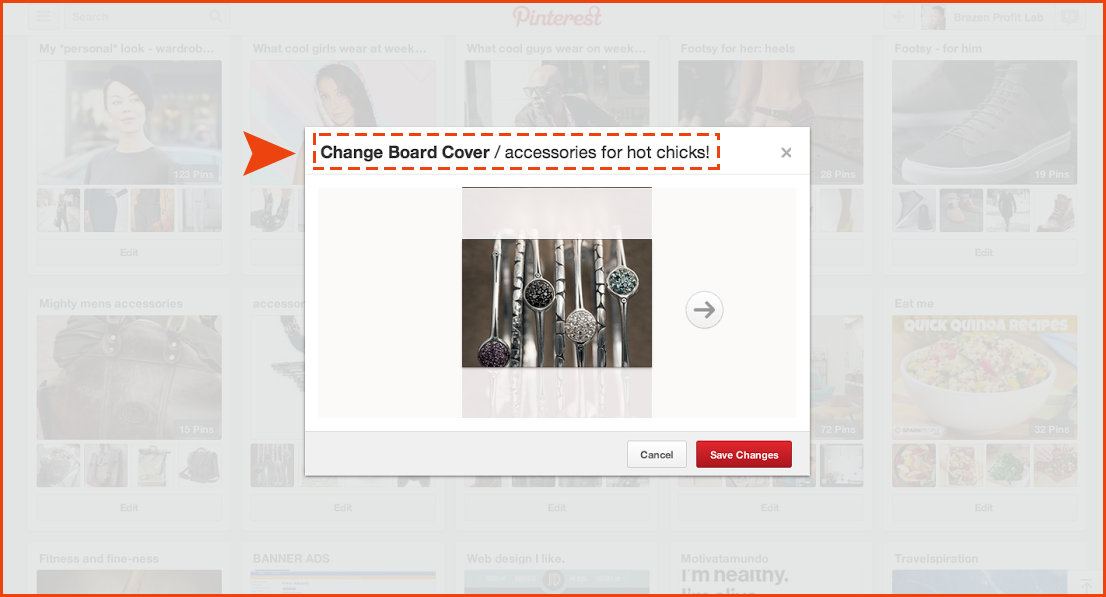
Change board cover.
Have an organized profile. Pinterest lets users curate, organize, and cull content in a very specific way. Boards that are disorganized, sparsely populated, or just generally unattractive will be ignored. Make a commitment to quality, only select the very best images for your profile, and keep them organized on the relevant boards — even if that means keeping some boards in private mode until you have at least 15 images.
Pinterest Don’ts for Ecommerce Merchants
Do not go on a pinning spree. This is the quickest way to get unfollowed. If you’ve spent any time on the platform, you’ll know when one of the people you follow has been on a pinning spree. You’ll see 15 images of garden furniture, 20 ideas for bridesmaid hair decorations – and you’ll need to scroll and scroll and scroll until you see something that interests you. It’s this sort of pinning spree that gets people unfollowed.
A better strategy is to pin a variety of content regularly, and to try and have even pin distribution across your boards.
Do not use poor quality, low-resolution images. Whether pins of your product, or just something your audience would find interesting, resist the urge to contribute anything less than high-quality images to the platform. Make sure everything you contribute is representative of your brand.

Poor quality graphic example.

Good quality graphic example.
Do not post only your own content. This is like people who show up at the party and only talk about themselves. It’s boring, and they soon find themselves alone. Only posting your own content says a few things about your brand.
- You have no idea, or do not care, about the interests of your audience.
- You don’t understand the reciprocity of social media, or know how to manage a community.
Pinterest relies on give and take. Make sure you’re adding to the platform as well as marketing through it.
You should have brand-specific boards. But make sure you also have a variety of boards that cover your target customers’ interests. This will also allow you to feature your best products beside them.

Branded boards on Pinterest.
Do not be inconsistent. You want your followers to know what to expect from you. That doesn’t mean being boring, or that you can’t throw in the occasional wild card. But it does mean pinning frequently, every day if possible. There are tools to help you automate that. Pin images that are of a consistent quality, and only pin other content which complements your brand’s messaging or aesthetic.

Consistent look and feel on Pinterest.
Do not ignore group boards, both participating and having your own. Group boards are community boards for invited members to pin on the same topic. The sorts of boards you want to participate in are well curated, have a number of active members, and moderators are quick to remove people who violate the spirit of the group board.
You don’t have to wait to get an invite to a group board, why not start your own? Perhaps you have a topic that you think your community or people you follow could do a good job on contributing to. Start up a group board, set a foundation of roughly 40 pins, and then start inviting people to participate.
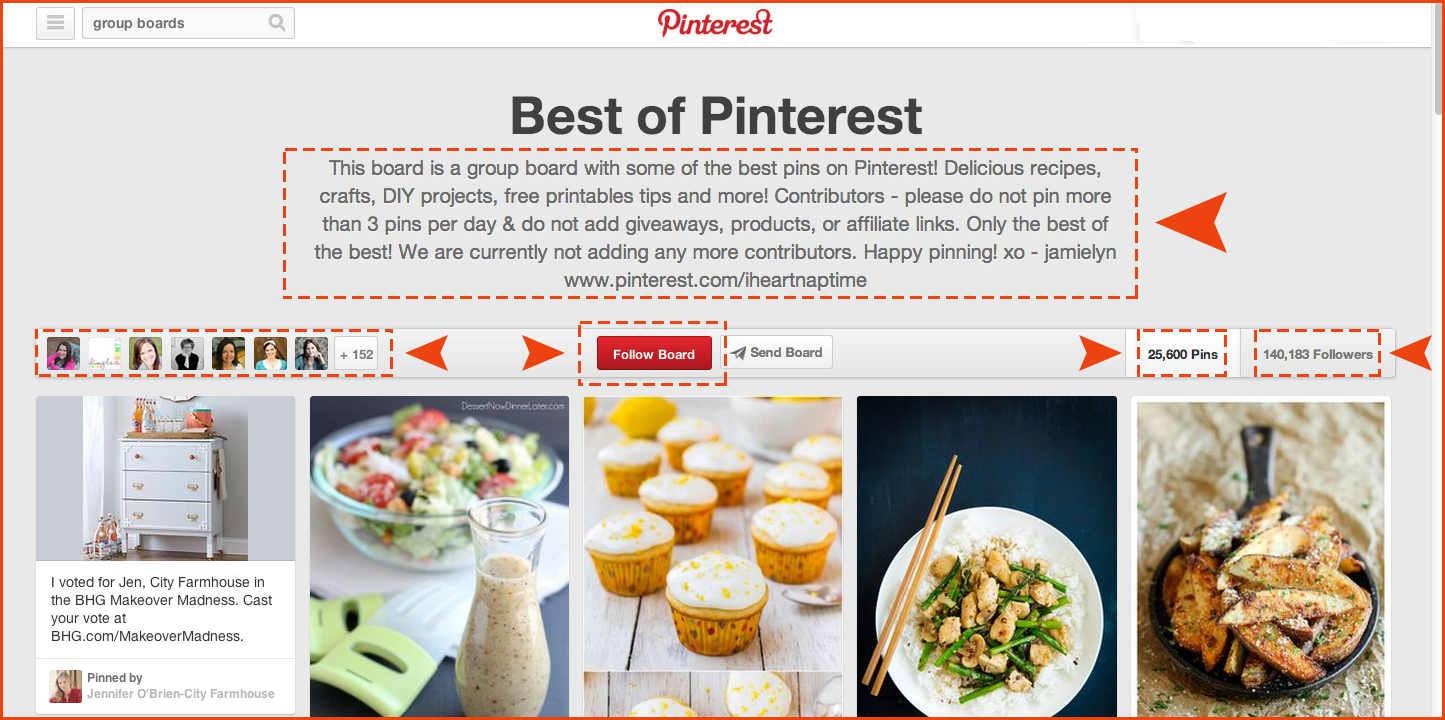
Group boards.
Whether you are starting a Pinterest marketing strategy, or trying to improve your existing one, following these dos and don’ts will help ensure you’re on the right track.



